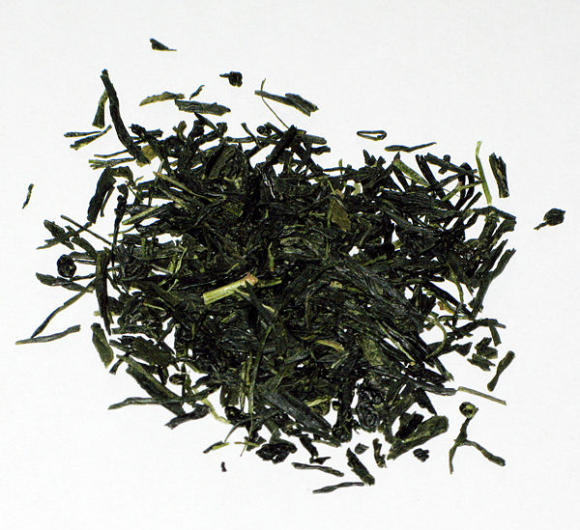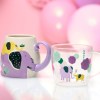
Japan may have invented the tea ceremony, but that doesn’t mean that every occasion to drink the beverage is considered a solemn cultural experience. Modern residents of Japan don’t generally have the time for a highly ritualized brewing and sipping of a cup of tea, and are instead far more likely to satisfy their cravings with an inexpensive bottle of green tea bought from a vending machine or convenience store.
But swinging the pendulum back the other way is beverage company Ito En, which is releasing a super-premium bottled green tea made with Japan’s highest quality leaves, and an eye-popping price to match.
Just about every convenience store and supermarket in Japan keeps a stock of Ito En’s Oi Ocha teas on hand, and you can find them for sale in vending machines as well. There’s a lot of variety to the line too. Of course standard ocha green tea is available, as are roasted hojicha, matcha, and other varieties, many of which are sold both hot or cold.
Oi Ocha gets high marks from Japanese consumers for its taste, and with most varieties priced at about 150 yen (US$1.25), the teas are perennial big sellers. Ito En’s newest addition to the Oi Ocha line, however, is seeking to move its affordable luxury a bit more towards the “luxury” end of the equation.
One of Japan’s most prized types of tea leaves is gyokuro. Gyokuro leaves are cultivated in the shade for the final 20 days or so before picking, and protecting them from the harsh sunlight boosts their concentration of flavorful theanine amino acids.
▼ Gyokuro leaves
Because of the extra effort and cost involved in producing gyokuro, it’s often mixed with other, less expensive types of green tea, adding a dash of flavor and elegance to the mix. From October 26, though, Ito En will be selling a limited edition of Oi Ocha made entirely from gyokuro, priced at 1,000 yen (US$8.40) for a 375-milliliter (12.7-ounce) bottle, which makes it by far the most expensive member of the Oi Ocha lineup.
Fittingly, Ito En isn’t pushing the all-gyokuro version as something to gulp down during your lunch break, but as something to serve to guests or to give as a present (high-quality food and beverages are always appreciated gifts in Japan, after all). And while there’s no denying the 1,000-yen price tag causes a bit of sticker shock, on a per-milliliter basis it works out to about the same as a 2,000-yen bottle of wine, something many gourmands would say is a perfectly acceptable amount to pay for a palate-pleasing accent or follow-up to a fine meal.
<!em>Sources: Japaan, Ito En
Top image: Ito En (edited by RocketNews24)
Insert image: Wikipedia/Rama


 Japan’s Oi Ocha green tea keeps going upscale with new bottled matcha costing 1,000 yen a bottle
Japan’s Oi Ocha green tea keeps going upscale with new bottled matcha costing 1,000 yen a bottle Drink Green! We check out the amazing “Green Tea Party” presented by Isetan and Ito En! 【Pics】
Drink Green! We check out the amazing “Green Tea Party” presented by Isetan and Ito En! 【Pics】 Japanese tea commercial actress created by AI, has some wondering if it’s the scandal-free future
Japanese tea commercial actress created by AI, has some wondering if it’s the scandal-free future Newest Gundam anime robot model kit is made with green tea leaves, smells like green tea
Newest Gundam anime robot model kit is made with green tea leaves, smells like green tea Our Japanese reporter visits Costco in the U.S., finds super American and very Japanese things
Our Japanese reporter visits Costco in the U.S., finds super American and very Japanese things Foreigner’s request for help in Tokyo makes us sad for the state of society
Foreigner’s request for help in Tokyo makes us sad for the state of society Japanese city loses residents’ personal data, which was on paper being transported on a windy day
Japanese city loses residents’ personal data, which was on paper being transported on a windy day Osaka governor suggests lowering voting age to 0 to curb population decline
Osaka governor suggests lowering voting age to 0 to curb population decline Historical figures get manga makeovers from artists of Spy x Family, My Hero Academia and more
Historical figures get manga makeovers from artists of Spy x Family, My Hero Academia and more Harajuku Station’s beautiful old wooden building is set to return, with a new complex around it
Harajuku Station’s beautiful old wooden building is set to return, with a new complex around it Starbucks Japan releases new mugs and gifts for Mother’s Day
Starbucks Japan releases new mugs and gifts for Mother’s Day Suntory x Super Mario collaboration creates a clever way to transform into Mario【Videos】
Suntory x Super Mario collaboration creates a clever way to transform into Mario【Videos】 Smash Bros. director Sakurai stabs Kirby in the face, has delicious justification for it
Smash Bros. director Sakurai stabs Kirby in the face, has delicious justification for it Anime girl English teacher Ellen-sensei becomes VTuber/VVTUber and NFT
Anime girl English teacher Ellen-sensei becomes VTuber/VVTUber and NFT Beautiful Red and Blue Star luxury trains set to be Japan’s new Hokkaido travel stars
Beautiful Red and Blue Star luxury trains set to be Japan’s new Hokkaido travel stars McDonald’s new Happy Meals offer up cute and practical Sanrio lifestyle goods
McDonald’s new Happy Meals offer up cute and practical Sanrio lifestyle goods Japanese ramen restaurants under pressure from new yen banknotes
Japanese ramen restaurants under pressure from new yen banknotes French Fries Bread in Tokyo’s Shibuya becomes a hit on social media
French Fries Bread in Tokyo’s Shibuya becomes a hit on social media Studio Ghibli releases new action figures featuring Nausicaä of the Valley of the Wind characters
Studio Ghibli releases new action figures featuring Nausicaä of the Valley of the Wind characters New private rooms on Tokaido Shinkansen change the way we travel from Tokyo to Kyoto
New private rooms on Tokaido Shinkansen change the way we travel from Tokyo to Kyoto Red light district sushi restaurant in Tokyo shows us just how wrong we were about it
Red light district sushi restaurant in Tokyo shows us just how wrong we were about it Tokyo Tsukiji fish market site to be redeveloped with 50,000-seat stadium, hotel, shopping center
Tokyo Tsukiji fish market site to be redeveloped with 50,000-seat stadium, hotel, shopping center All-you-can-drink Starbucks and amazing views part of Tokyo’s new 170 meter-high sky lounge
All-you-can-drink Starbucks and amazing views part of Tokyo’s new 170 meter-high sky lounge Beautiful Ghibli sealing wax kits let you create accessories and elegant letter decorations【Pics】
Beautiful Ghibli sealing wax kits let you create accessories and elegant letter decorations【Pics】 Studio Ghibli releases Kiki’s Delivery Service chocolate cake pouches in Japan
Studio Ghibli releases Kiki’s Delivery Service chocolate cake pouches in Japan New definition of “Japanese whiskey” goes into effect to prevent fakes from fooling overseas buyers
New definition of “Japanese whiskey” goes into effect to prevent fakes from fooling overseas buyers Our Japanese reporter visits Costco in the U.S., finds super American and very Japanese things
Our Japanese reporter visits Costco in the U.S., finds super American and very Japanese things Studio Ghibli unveils Mother’s Day gift set that captures the love in My Neighbour Totoro
Studio Ghibli unveils Mother’s Day gift set that captures the love in My Neighbour Totoro More foreign tourists than ever before in history visited Japan last month
More foreign tourists than ever before in history visited Japan last month New Pokémon cakes let you eat your way through Pikachu and all the Eevee evolutions
New Pokémon cakes let you eat your way through Pikachu and all the Eevee evolutions Sales of Japan’s most convenient train ticket/shopping payment cards suspended indefinitely
Sales of Japan’s most convenient train ticket/shopping payment cards suspended indefinitely Sold-out Studio Ghibli desktop humidifiers are back so Totoro can help you through the dry season
Sold-out Studio Ghibli desktop humidifiers are back so Totoro can help you through the dry season Japanese government to make first change to romanization spelling rules since the 1950s
Japanese government to make first change to romanization spelling rules since the 1950s Ghibli founders Toshio Suzuki and Hayao Miyazaki contribute to Japanese whisky Totoro label design
Ghibli founders Toshio Suzuki and Hayao Miyazaki contribute to Japanese whisky Totoro label design Doraemon found buried at sea as scene from 1993 anime becomes real life【Photos】
Doraemon found buried at sea as scene from 1993 anime becomes real life【Photos】 Tokyo’s most famous Starbucks is closed
Tokyo’s most famous Starbucks is closed One Piece characters’ nationalities revealed, but fans have mixed opinions
One Piece characters’ nationalities revealed, but fans have mixed opinions We asked a Uniqlo employee what four things we should buy and their suggestions didn’t disappoint
We asked a Uniqlo employee what four things we should buy and their suggestions didn’t disappoint Princesses, fruits, and blacksmiths: Study reveals the 30 most unusual family names in Japan
Princesses, fruits, and blacksmiths: Study reveals the 30 most unusual family names in Japan Transform your bottle of tea into Sailor Senshi with these cool Sailor Moon covers from Mini Stop
Transform your bottle of tea into Sailor Senshi with these cool Sailor Moon covers from Mini Stop Tea with free Pokémon bottle covers at Japanese convenience stores charm, then break, our hearts
Tea with free Pokémon bottle covers at Japanese convenience stores charm, then break, our hearts Kyoto matcha green tea popcorn, the latest must-eat snack from…Frito-Lay?!?
Kyoto matcha green tea popcorn, the latest must-eat snack from…Frito-Lay?!? The cold getting to you? Have a warm drink — from a vending machine!
The cold getting to you? Have a warm drink — from a vending machine! Green tea continues to go alcoholic with new matcha liqueur from Suntory
Green tea continues to go alcoholic with new matcha liqueur from Suntory Japanese vending machines now sell spicy “drinkable cold ramen,” but how is this chilled fire?
Japanese vending machines now sell spicy “drinkable cold ramen,” but how is this chilled fire? Japanese convenience store or Japanese supermarket: Which one is cheaper?
Japanese convenience store or Japanese supermarket: Which one is cheaper? Pikachu, I choose you… to take over vending machines in Japan!【Video】
Pikachu, I choose you… to take over vending machines in Japan!【Video】 Vending machine makes commuters smile at Japanese train station
Vending machine makes commuters smile at Japanese train station Japanese idol singers offer bottles of their used bathwater to fans at eye-popping price
Japanese idol singers offer bottles of their used bathwater to fans at eye-popping price Is this $900 box of Japanese chocolates the perfect indulgence for sweets lovers?
Is this $900 box of Japanese chocolates the perfect indulgence for sweets lovers? Japanese vending machines now have the strangest thing we never knew we needed: hot bottled water
Japanese vending machines now have the strangest thing we never knew we needed: hot bottled water Yogurt-flavored water?!? We try Suntory’s new beverage straight, mix it with booze 【Taste test】
Yogurt-flavored water?!? We try Suntory’s new beverage straight, mix it with booze 【Taste test】 The new Namacha reminds us that not all bottled green teas are created equal 【Taste test】
The new Namacha reminds us that not all bottled green teas are created equal 【Taste test】 Starbucks to sell limited-edition hojicha latte cups at convenience stores for the summer
Starbucks to sell limited-edition hojicha latte cups at convenience stores for the summer
Leave a Reply